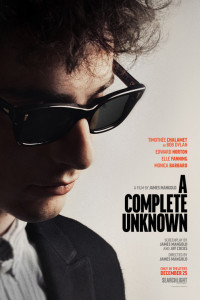 A lot has been said and written about A Complete Unknown, pretty much all of it of it good. There are so many ways for a movie like this to go wrong, and director James Mangold seems to have avoided pretty much all of them. It’s been nominated for eight Oscars: Best picture, best director, best leading actor, best supporting actor and actress, best adapted screenplay, costuming, and sound. I’ve seen hardly any of the competition yet and don’t feel I can comment on the big award nominations, but the screenplay, costuming and sound in this film are all superb and deserving of honors.
A lot has been said and written about A Complete Unknown, pretty much all of it of it good. There are so many ways for a movie like this to go wrong, and director James Mangold seems to have avoided pretty much all of them. It’s been nominated for eight Oscars: Best picture, best director, best leading actor, best supporting actor and actress, best adapted screenplay, costuming, and sound. I’ve seen hardly any of the competition yet and don’t feel I can comment on the big award nominations, but the screenplay, costuming and sound in this film are all superb and deserving of honors.
In case you’ve been living under a rock (and believe me, some days I wish I was), this film covers the chaotic life of Bob Dylan from his arrival in New York in 1961 until his controversial performance with a rock band at the Newport Folk Festival in 1965. It’s adapted from Elijah Wald’s critically acclaimed and popular 2015 book Dylan Goes Electric!. Even with a running time of 2 hours, 15 minutes or so, the movie severely compresses much of the story, eliminating a bunch of people and happenings, and just generally re-jiggering the timeline in a lot of ways that even this only mildly obsessive Dylan fan noticed. It entirely removes the highly influential part Ramblin’ Jack Elliot played in Dylan’s early career, for instance — giving Ed Norton’s delightful Pete Seeger character the bulk of the credit for introducing Dylan to the Greenwich Village folk scene. It (mis)places Seeger at the hospital when Dylan goes to meet and play for Woody Guthrie. It skips lightly over the months or even years that Dylan couch-surfed around the Village (and notoriously rarely bathed) while singing unpaid gigs in folk clubs. It has him hopping almost directly from Suze Rotolo (here called Sylvie Russo)’s bed into Joan Baez’s, and back again a couple of times. It puts his electric debacle at Newport as the closing set on the last night, which it wasn’t. Etc.
None of that matters. As Josh Marshall of Talking Points Memo said in a superb blog post:
What also makes it work is that right off the bat James Mangold, who directed the movie and also co-wrote the screenplay, tosses out the specific details of how key events happened and allows himself to be creative with the timeline. That kind of compression and reworking is standard in movies about historical events. Here it involves a bit more risk since a lot of people know the details. But it made the whole thing more fresh. It set the stage for the rest of the movie because I was immediately on notice: this is an impressionist painting, not a photograph. Take it on that basis.
Regardless of all of that, if you’re of certain generations, like my Boomers or Gen X, this is a 2 hour and 15 minute goosebump fest. A lot of you know all of the songs, perhaps all of the words, but all of you will know most of them. The settings, props, cars and costumes are spot on. Timothée Chalamet totally nails Dylan and does an incredible job singing the songs — as does Monica Barbaro as Joan Baez. Ed Norton is a joy as Seeger, at once sagacious and sweetly naive. Boyd Holbrook kicks ass as Johnny Cash, and the screenplay rightly spotlights the role Cash played in Dylan’s career as one of his most ardent and vocal fans and boosters.
Mangold and his music director must have had so much fun with the soundtrack. They’ve buried lots of wonderful sonic Easter eggs everywhere. Just before Cash makes his first appearance, we see and hear Dylan working out the lyrics to “Girl From The North Country,” which the two sang as a duet on Bob’s Nashville Skyline in 1969. The soundtrack has dozens of credits that most of us will never notice unless we watch the movie several times, like Calexico’s rendition of “Billy,” the main theme from Pat Garrett and Billy The Kid, the 1973 movie.
The only slightly weak part is the character of Sylvie Russo (Elle Fanning), which is a composite of Rotolo and several other girlfriends had during the period. Sylvie is turned into something of a stock romantic interest who keeps coming back for more even when she should know better, and to me came off as limp and insipid after a while. For a better look at the real Rotolo, check out this interview of her on “Fresh Air” from several years back.
I’m very happy that I saw this in a theater. The music is beautifully rendered and the sound design superb. I can’t recommend A Complete Unknown highly enough.
(Searchlight Pictures, 2024)
